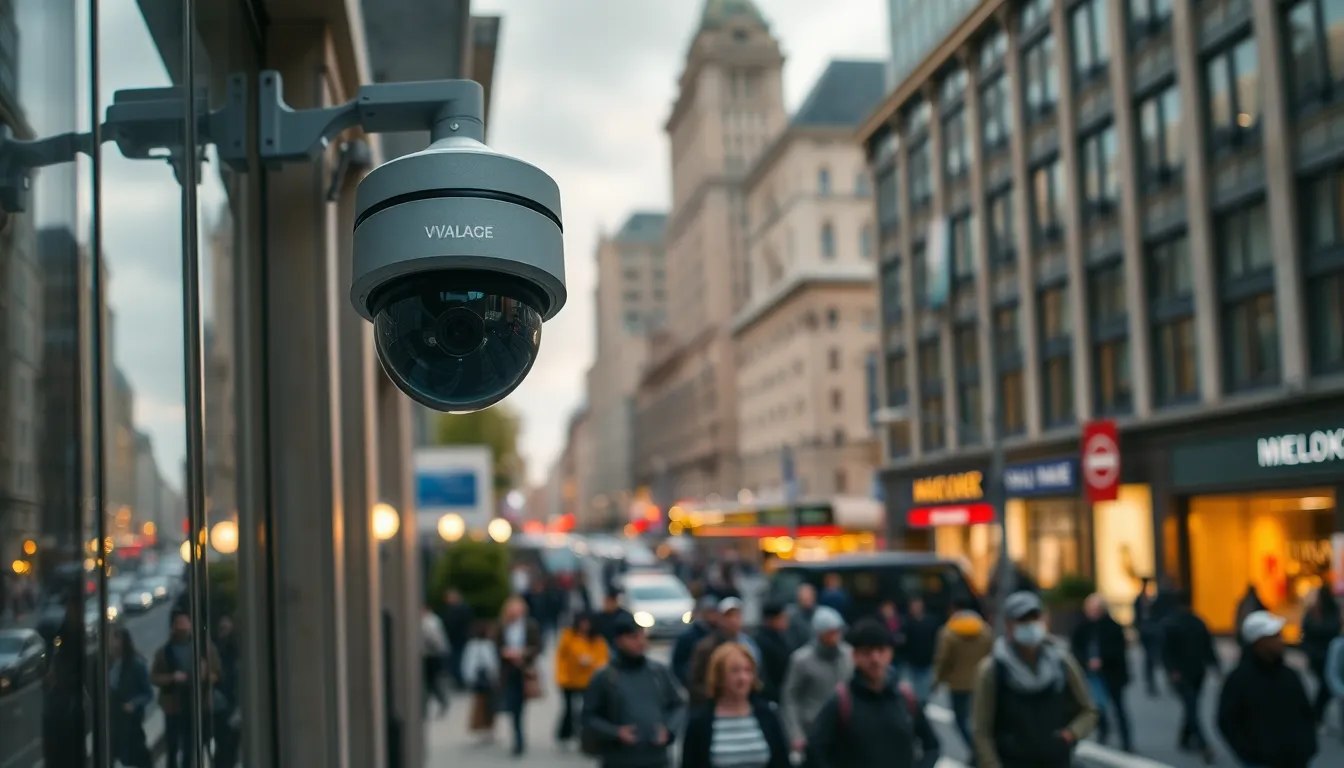In a world where privacy seems as elusive as a cat in a room full of rocking chairs, AI-powered surveillance is stepping into the spotlight. Imagine a watchful eye that never blinks, tirelessly analyzing data to keep us safe—or at least that’s the pitch. With algorithms sharper than a tack and cameras that could spot a squirrel in a snowstorm, this technology promises to revolutionize security as we know it.
But before you start picturing a dystopian future straight out of a sci-fi flick, let’s explore how AI surveillance balances the fine line between safety and privacy. It’s not just about watching; it’s about understanding. So, grab your popcorn and settle in as we dive into the fascinating world of AI surveillance, where the future is both thrilling and a tad bit unnerving.
Table of Contents
ToggleOverview Of AI-Powered Surveillance
AI-powered surveillance refers to the integration of artificial intelligence in security systems, enhancing monitoring capabilities significantly. This technology employs advanced algorithms to process video feeds, analyze patterns, and identify unusual behaviors. High-tech cameras equipped with AI can detect faces, recognize license plates, and track movements in real time.
Organizations are increasingly adopting AI surveillance due to its efficiency and capability to streamline security protocols. These systems can operate continuously, reducing the burden on human operators. Additionally, AI algorithms provide invaluable insights by collecting and interpreting data from various sources, aiding in decision-making.
Privacy concerns arise from the extensive use of AI in surveillance. Critics highlight risks related to data misuse, unauthorized access, and potential surveillance overreach. Citizens worry about being constantly monitored, leading to a chilling effect on freedom and personal privacy.
Regulations surrounding AI surveillance vary widely across jurisdictions. In some regions, strict guidelines help ensure transparency and accountability, while others lack comprehensive frameworks. A balanced approach is crucial to harnessing the benefits of AI surveillance while safeguarding civil liberties.
AI-powered surveillance stands at the intersection of enhancing security and preserving privacy. As technology evolves, ongoing dialogue among stakeholders, including policymakers, technologists, and civil rights advocates, will shape its future.
Benefits Of AI-Powered Surveillance
AI-powered surveillance systems provide numerous benefits for security and efficiency. These technologies enhance monitoring capabilities through advanced analytics and real-time data processing.
Enhanced Security Monitoring
Enhanced security monitoring stands out as a primary advantage of AI-powered surveillance. These systems use high-tech cameras equipped with facial recognition technology and motion detection algorithms. They continuously monitor premises to identify potential threats in real time. Organizations employing AI-driven surveillance can respond swiftly to incidents, significantly reducing response times. Alerts generated by the system allow security teams to focus on high-priority situations. The ability to analyze multiple camera feeds simultaneously ensures comprehensive coverage across various locations.
Efficient Data Analysis
Efficient data analysis is another key benefit of AI-powered surveillance. Algorithms process vast amounts of data swiftly, identifying patterns and trends that humans might overlook. Automated systems filter out irrelevant information, allowing for focused analysis of critical events. Predictive analytics in AI can anticipate security breaches based on historical data, contributing to proactive measures. Utilizing machine learning enhances the accuracy of identifying suspicious activities over time. Organizations report improved decision-making as a result of these insights. Overall, streamlined data processing empowers security teams to allocate resources more effectively.
Ethical Concerns Surrounding AI-Powered Surveillance
AI-powered surveillance raises significant ethical concerns, particularly regarding privacy and discrimination. Understanding these issues is vital for navigating the complex landscape of modern security technology.
Privacy Issues
Privacy issues stem from the vast amounts of data collected by AI surveillance systems. Organizations often capture personal information without consent, prompting fears of unauthorized data use. Continuous monitoring can lead to a chilling effect on individual freedoms, as people alter their behavior when aware of being watched. Critics argue that a lack of transparency exacerbates these problems, as individuals may remain unaware of how their data is utilized. Regulatory frameworks vary widely, leaving many citizens vulnerable to invasive practices.
Bias and Discrimination
Bias and discrimination pose additional ethical challenges in AI surveillance. Algorithms often reflect existing societal prejudices, leading to disproportionate targeting of specific demographics. Racial and socioeconomic factors frequently influence surveillance outcomes, resulting in unfair treatment. In some cases, these biases impact law enforcement practices, which can perpetuate cycles of mistrust. Addressing these concerns requires thorough evaluation of algorithms and continuous monitoring for fairness and equity, ensuring that AI systems serve all communities justly.
Technological Advancements In AI-Powered Surveillance
Significant advancements in artificial intelligence are transforming surveillance systems, enhancing their efficiency and effectiveness. These innovations include the integration of robust machine learning algorithms and the ability for real-time data processing.
Machine Learning Algorithms
Machine learning algorithms play a crucial role in AI-powered surveillance. These algorithms analyze video feeds to detect unusual behaviors and patterns. They can recognize faces, vehicles, and activities with remarkable accuracy. By leveraging historical data, these algorithms refine their predictions. Organizations benefit from reduced false alarms due to improved identification capabilities. Enhanced learning models contribute to a more intelligent and responsive security environment. Pattern recognition allows for quicker adaptation, making surveillance systems increasingly effective.
Real-Time Data Processing
Real-time data processing enhances the responsiveness of AI surveillance systems. Systems continuously analyze incoming video streams, identifying potential threats as they appear. Cutting-edge technology ensures that data is processed rapidly, enabling immediate alerts. These systems can integrate information from various sources, such as sensors and databases. Speedy processing allows for swift interventions to prevent crimes or other incidents. Organizations gain valuable insights from trends identified in ongoing surveillance, which aid in future security planning. This capability is essential in managing large-scale surveillance efforts effectively.
Future Trends In AI-Powered Surveillance
Emerging trends in AI-powered surveillance focus on more sophisticated algorithms and increased automation. Organizations increasingly rely on artificial intelligence for continuous monitoring and immediate threat detection. Improved facial recognition systems enhance accuracy and reduce biases, making technology more reliable in identifying individuals.
Advancements in edge computing support real-time data processing at the source, minimizing latency and resource consumption. By using edge devices, organizations can analyze video feeds without needing constant cloud access. This capability increases operational efficiency and improves response times to potential threats.
Integration of AI with Internet of Things (IoT) devices broadens surveillance capabilities. Smart cameras equipped with sensors collect data on environmental conditions, enhancing understanding of context during incident analysis. Collaborative systems enable various devices to communicate, providing a comprehensive security solution tailored to specific needs.
More stringent regulations are likely to shape the future of AI-powered surveillance systems. Increased scrutiny over data collection practices ensures organizations prioritize transparency. Ethical guidelines will drive the development of technologies that respect individual privacy while maintaining security.
Ultimately, its future includes a push for explainable AI, giving organizations the ability to understand decision-making processes behind surveillance technologies. This transparency builds trust, enabling communities to engage with security measures more positively. Adopting these trends positions organizations to leverage AI-powered surveillance effectively while addressing ethical and privacy concerns.
Conclusion
AI-powered surveillance represents a transformative shift in security practices. Its ability to enhance monitoring and streamline data analysis offers organizations significant advantages in threat detection and response. However the ethical implications and privacy concerns associated with its implementation cannot be overlooked. Striking a balance between leveraging advanced technology and protecting civil liberties is essential for fostering trust within communities. As regulations evolve and technology advances organizations must commit to transparency and fairness in their surveillance practices. This approach will not only enhance security but also ensure that individual rights are respected in an increasingly monitored world.







